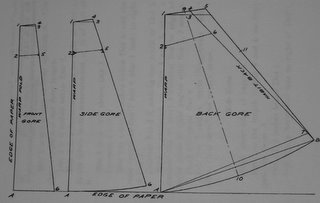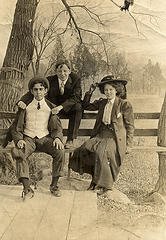 A few weeks ago a vintage white cotton petticoat came into my possession. Don't ask me how old it is...I am still trying to figure that out! However, it's likely that the skirt is late Edwardian or early teens, given the approximately 2-yard sweep. It's not very full at all.
A few weeks ago a vintage white cotton petticoat came into my possession. Don't ask me how old it is...I am still trying to figure that out! However, it's likely that the skirt is late Edwardian or early teens, given the approximately 2-yard sweep. It's not very full at all. - left front=5 3/4" I measured several times :}
- center front=6"
- right front=6"
- left back=5"
- right back=5"
Sweep (bottom gore width) measures:
Approximate sweep is 76", or just over 2 yards. That is quite narrow, but when worn feels roomy and does not constrict movement.
- left front=12.5"
- center front=12.5"
- right front=12.5"
- left back=17.5"
- left back width to top of gusset=17"
- right back=17.5"
- right back width to top of gusset=17"
Length of skirt, top to bottom=38" (highest point of scallops), 39" (lowest point of scallops)
Waistband=1/2" wide
Placket=5/8 " wide, 9" long, not including waistband.
Handmade, and Not Always Neatly!
All you hurried seamstresses out there can relax; it'd appear that what we'd call semi-sloppy seam finish work was definitely out there. Now the Williamsburg Foundation book, titled something like "What People Wore", says that 18th century clothes were often ill-finished on the interiors. Having to be completely hand sewn, and often reused and retooled until the poor garment fell apart, there was little point in finishing each seam. I understand from Elizabeth Stewart's excellent board, The Sewing Academy at Home, (see http://www.elizabethstewartclarkandcompany.com/Forum/index.php) that simply overcasting the edges of seams was a quick and effective and common way to finish seams at the mid nineteenth century. The sewing machine's wide adoption may have helped to make neat finishes not only more common, but more a social standard, or at least that's my personal suspicion. By the time a lot of teaching texts roll around at the turn of the 2oth century, nice, even fancy seam finishes were expected. However, as with ettiquette and cooking and fashion sense, what was expected was probably far less than universal on handmade clothes.
 On my petticoat? No fancy finishes there! The interior seams are simply overcast, and loosely at that, with not terribly even stitches in a fine thread. I was shocked, shocked! Rather hard to see on the picture of the interior of a back gusset at left, but you could try...
On my petticoat? No fancy finishes there! The interior seams are simply overcast, and loosely at that, with not terribly even stitches in a fine thread. I was shocked, shocked! Rather hard to see on the picture of the interior of a back gusset at left, but you could try...
Look at the way the waistband is sewn on, too. Nice tiny machine stitches, but look up close and you see, what's this? Edge stitching that wanders a bit and falls off the edge of the band? Quel horreur!
What It's Like to Wear This Petticoat
 The petticoat is surprisingly roomy. You'll laugh but we have no full-length mirror that doesn't suffer from an advanced case of silvering. So the only shot I have is taken in front of a small mirror propped on the staircase landing, and shows only my feet. You'll note the roominess and how nice those scallops look.
The petticoat is surprisingly roomy. You'll laugh but we have no full-length mirror that doesn't suffer from an advanced case of silvering. So the only shot I have is taken in front of a small mirror propped on the staircase landing, and shows only my feet. You'll note the roominess and how nice those scallops look.




 Frankly, I don't know what error I made or what principle of geometry is in effect that causes the bottom width of a gore to come out differently when you do it by math versus drawing it out.
But I did decide what to do. I kept that 90" sweep, as being befittingly narrow for 1911. Then I distributed 2 inches of extra to the back gore and 1" each to the side gore. If when I build it in muslin it makes me look dumpy, well then I'll redo it with a 112" sweep, and I will have learned how proportions affect the line of a dress in a visceral way.
Frankly, I don't know what error I made or what principle of geometry is in effect that causes the bottom width of a gore to come out differently when you do it by math versus drawing it out.
But I did decide what to do. I kept that 90" sweep, as being befittingly narrow for 1911. Then I distributed 2 inches of extra to the back gore and 1" each to the side gore. If when I build it in muslin it makes me look dumpy, well then I'll redo it with a 112" sweep, and I will have learned how proportions affect the line of a dress in a visceral way. 


